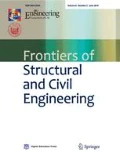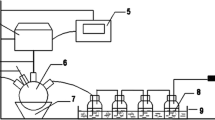Abstract
In this paper, studies on the modification on the low temperature coal tar pitch extracted from coal tar residue in Inner Mongolia are conducted. First, the low temperature coal tar pitch in liquid state is solidified with a higher softening point by chemical crosslinking modification. The modified coal tar pitch can achieve the standard pavement performance requirements. Then, the effects of chemical crosslinking agent and physical modification additives on the mechanical performance and toxic properties of coal tar pitch are investigated. The detoxification mechanism is also studied, which further promote the applicability of modified low temperature coal tar pitch in the pavement constructions.
Similar content being viewed by others
References
Zubkova V. Influence of polyethylene terephthalate on the carbonisation of bituminous coals and on the modification of their electric and dielectric properties. Fuel, 2006, 85(12): 1652–1665
Zhang L, Liu G, Wang Y, Shen J, Li R, Du J, Yang Z, Xu Q. Modification of coal tar pitch with P-phthalaldehyde to reduce toxic PAH content. Energy Sources. Part A, Recovery, Utilization, and Environmental Effects, 2016, 38(5): 737–743
Stompeil x y Z, and Collin g, Szen a. Koks smola Gaz, 1998,33 (L): 24
Li Q, Bai H, Zhang J, Fang H, Wang G, Xiang D. Comparison of SBS and EVA in modifying carbobitumen. Journal of Wuhan University of Science and Technology, 2009, 32(3): 293–295 (Natural Science Edition)
Efimova O S, Khokhlova G P, Patrakov Y F. Thermal conversion of coal-tar pitch in the presence of silicon compounds. Solid Fuel Chemistry, 2010, 44(1): 5–11
Czosnek C, Ratuszek W, Janik J F, Olejniczak Z. XRD and 29Si MAS NMR spectroscopic studies of carbon materials obtained from pyrolyses of a coal tar pitch modified with various silicon-bearing additives. Fuel Processing Technology, 2002, 79(3): 199–206
Bhatia G, Aggarwal R K, Chari S S, Jain G C. Rheological characteristics of coal tar and petroleum pitches with and without additives. Carbon, 1977, 15(4): 219–223
Wang Y, He Z, Zhan L, Liu X. Coal tar pitch based carbon foam for thermal insulating material. Materials Letters, 2016, 169: 95–98
Tan Y Q, Guo M, Cao L P, Zhang L. Performance Optimization of Composite Modified Asphalt Sealant based on Rheological Behavior. Construction & Building Materials, 2013, 47: 799–805
Guo M, Motamed A, Tan Y Q, Bhasin A. Investigating the Interaction between Asphalt Binder and Fresh and Simulated RAP Aggregate. Materials & Design, 2016, 105: 25–33
Tan Y Q, Guo M. Using Surface Free Energy Method to Study the Cohesion and Adhesion of Asphalt Mastic. Construction & Building Materials, 2013, 47: 254–260
Tan Y Q, Guo M. Study on the Phase Behavior of Asphalt Mastic. Construction & Building Materials, 2013, 47: 311–317
Lin Q, Li J, Yang Y, Xie Z. Thermal behavior of coal-tar pitch modified with BMI resin. Journal of Analytical and Applied Pyrolysis, 2010, 87(1): 29–33
Schneider K, Roller M, Kalberlah F, Schuhmacher-wolz U. Cancer risk assessment for oral exposure to PAH mixtures. Journal of Applied Toxicology, 2002, 22(1): 73–83
Hou Y, Wang L, Yue P, Pauli T, Sun W. Modeling Mode I Cracking Failure in Asphalt Binder by Using Nonconserved Phase-Field Model. Journal of Materials in Civil Engineering, 2014, 26(4): 684–691
Hou Y, Yue P, Wang L, Sun W. Fracture Failure in Crack interaction of Asphalt Binder by Using a Phase Field Approach. Materials and Structures, 2015a, 48(9): 2997–3008
Hou Y, Wang L, Pauli T, Sun W. Investigation of the Asphalt Selfhealing Mechanism Using a Phase-Field Model. Journal of Materials in Civil Engineering, 2015, 27(3): 04014118
Hou Y, Sun F, Sun W, Guo M, Xing C, Wu J. Quasi-brittle Fracture Modeling of Pre-Flawed Bitumen Using a Diffuse Interface Model. Advances in Materials Science and Engineering. 2016a, (6): 1–7
Hou Y, Sun W, Das P, Song X, Wang L, Ge Z, Huang Y. Coupled Navier-Stokes Phase-Field Model to Evaluate the Microscopic Phase Separation in Asphalt Binder under Thermal Loading. Journal of Materials in Civil Engineering, 2016b, 28(10): 04016100
Hou Y, Wang L, Wang D, Liu P, Guo M, Yu J. Characterization of Bitumen Micro-mechanical Behaviors Using AFM, Phase Dynamics Theory and MD simulation. Materials, 2017, 10(2): 208.
Acknowledgements
The research performed in this paper is supported by the National Natural Science Foundation of China (No.41372320), and Fundamental Research Funds for the Central Universities (06500036).
Author information
Authors and Affiliations
Corresponding author
Rights and permissions
About this article
Cite this article
Sun, F., Liu, Y. Investigation on the performance and detoxification of modified low temperature coal tar pitch. Front. Struct. Civ. Eng. 11, 315–321 (2017). https://doi.org/10.1007/s11709-017-0386-x
Received:
Accepted:
Published:
Issue Date:
DOI: https://doi.org/10.1007/s11709-017-0386-x



